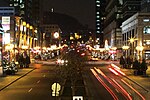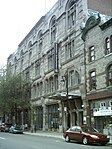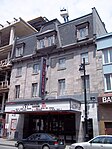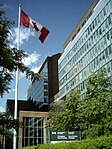Hydro-Québec Building
Downtown MontrealGovernment buildings completed in 1962Headquarters in CanadaHydro-QuébecModernist architecture in Canada ... and 6 more
Montreal stubsOffice buildings completed in 1962Quebec building and structure stubsQuebec government buildingsSkyscraper office buildings in CanadaSkyscrapers in Montreal

The Hydro-Québec Building (French: Édifice Hydro-Québec) in Montreal, Quebec, Canada stands at 110 metres (360 ft) with 27 floors. Completed in 1962, it houses the headquarters for Hydro-Québec as well the Montreal offices of the Premier of Quebec. The building was designed by Gaston Gagnier.The building is located on René-Lévesque Boulevard, named for former premier René Lévesque, who had nationalized Quebec's hydroelectric companies in 1963 while serving as Minister of Hydroelectric Resources and Public Works in the government of Jean Lesage. A bust of Lévesque was unveiled in front of the building on August 24, 2001.
Excerpt from the Wikipedia article Hydro-Québec Building (License: CC BY-SA 3.0, Authors, Images).Hydro-Québec Building
Boulevard René-Lévesque Ouest, Montreal Ville-Marie
Geographical coordinates (GPS) Address Nearby Places Show on map
Geographical coordinates (GPS)
| Latitude | Longitude |
|---|---|
| N 45.508333333333 ° | E -73.5625 ° |
Address
Hydro-Québec
Boulevard René-Lévesque Ouest
H2Z 1A2 Montreal, Ville-Marie
Quebec, Canada
Open on Google Maps











